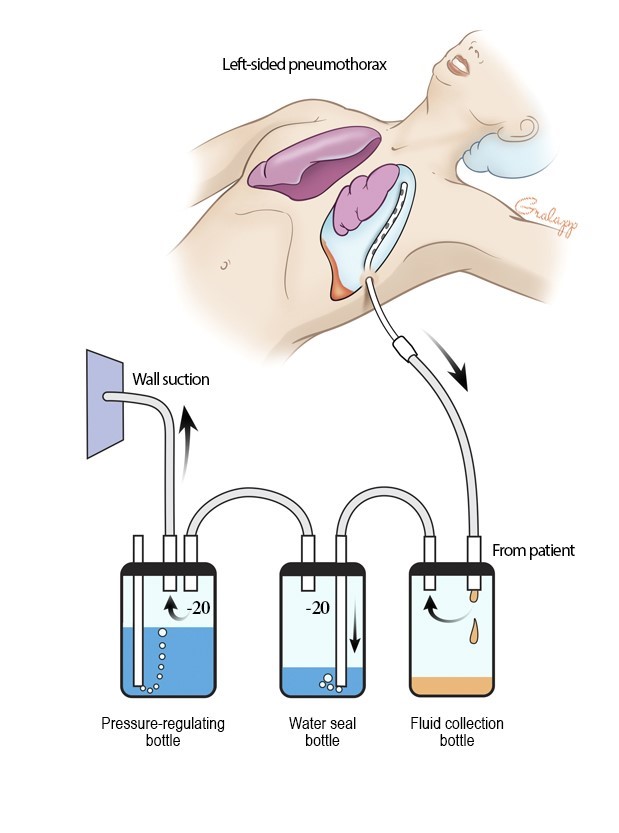A nurse is contributing to the plan of care for a client who has a chest tube set to continuous suction to relieve a pneumothorax. Which of the following interventions should the nurse include?
Ensure the device is kept below the level of the client's chest.
Clamp the chest tube every 4 hr.
Place the client in a supine position.
Empty the collection chamber every 8 hr.
The Correct Answer is A
Ensuring the device is kept below the level of the client's chest is important to ensure that the drainage system functions properly by allowing the fluid and air to flow downhill. Placing the device below the level of the chest helps facilitate gravity drainage.

Continuous suction is required for proper functioning of the chest tube drainage system. Clamping the chest tube can disrupt the suction and impede the removal of air or fluid from the pleural space. Only in specific circumstances, such as when changing the drainage system or assessing for air leaks, may the healthcare provider request a temporary clamping of the chest tube.
Positioning the client semi-Fowler's, with the head of the bed elevated, can help promote lung expansion and improve oxygenation. The specific positioning may vary depending on the client's condition and the healthcare provider's recommendations.
The nurse should empty the collection chamber as per the facility's protocol, which typically includes monitoring the drainage and emptying it when it reaches a certain level. Regular emptying of the collection chamber helps maintain proper functioning of the chest tube system and allows for accurate measurement of drainage output.
Nursing Test Bank
Naxlex Comprehensive Predictor Exams
Related Questions
Correct Answer is B
Explanation
Veracity refers to the principle of truthfulness and honesty in communication. By truthfully communicating about the adverse effects of the prescribed medications, the nurse is demonstrating veracity. This ethical principle emphasizes the importance of providing accurate information to the client to promote informed decision-making and autonomy.
Justice refers to fairness and equitable treatment, ensuring that individuals receive what they are due and that resources are distributed appropriately. While justice is an important ethical concept in healthcare, it is not directly applicable to the nurse's communication about adverse effects.
Autonomy refers to respecting the right of individuals to make their own decisions and choices regarding their healthcare. While truthfully communicating about adverse effects supports autonomy, autonomy itself is not the specific ethical concept being exhibited in this scenario. Beneficence refers to the ethical principle of acting in the best interest of the client and promoting their well-being. While providing accurate information about adverse effects can be seen as a form of beneficence, it does not directly address the nurse's truthful communication in this specific scenario.
Correct Answer is D
Explanation
Explanation
D, Elevated ammonia
Cirrhosis is a chronic liver disease characterized by the progressive scarring of liver tissue. As liver function becomes impaired, there is a decrease in the liver's ability to metabolize and detoxify substances, including ammonia. Elevated ammonia levels in the blood, known as hyperammonemia, are commonly seen in clients with advanced cirrhosis.
Elevated amylase in (option A) is incorrect because it is typically seen in conditions affecting the pancreas, such as pancreatitis, and is not specific to cirrhosis.
Decreased bilirubin levels in (option B) is incorrect because they are not expected in cirrhosis. In fact, bilirubin levels are often elevated in cirrhosis due to impaired liver function and the accumulation of bilirubin in the blood.
Elevated lipase in (option C) is incorrect because it is typically seen in pancreatic disorders, such as pancreatitis, and is not specific to cirrhosis.
Whether you are a student looking to ace your exams or a practicing nurse seeking to enhance your expertise , our nursing education contents will empower you with the confidence and competence to make a difference in the lives of patients and become a respected leader in the healthcare field.
Visit Naxlex, invest in your future and unlock endless possibilities with our unparalleled nursing education contents today
Report Wrong Answer on the Current Question
Do you disagree with the answer? If yes, what is your expected answer? Explain.
Kindly be descriptive with the issue you are facing.
